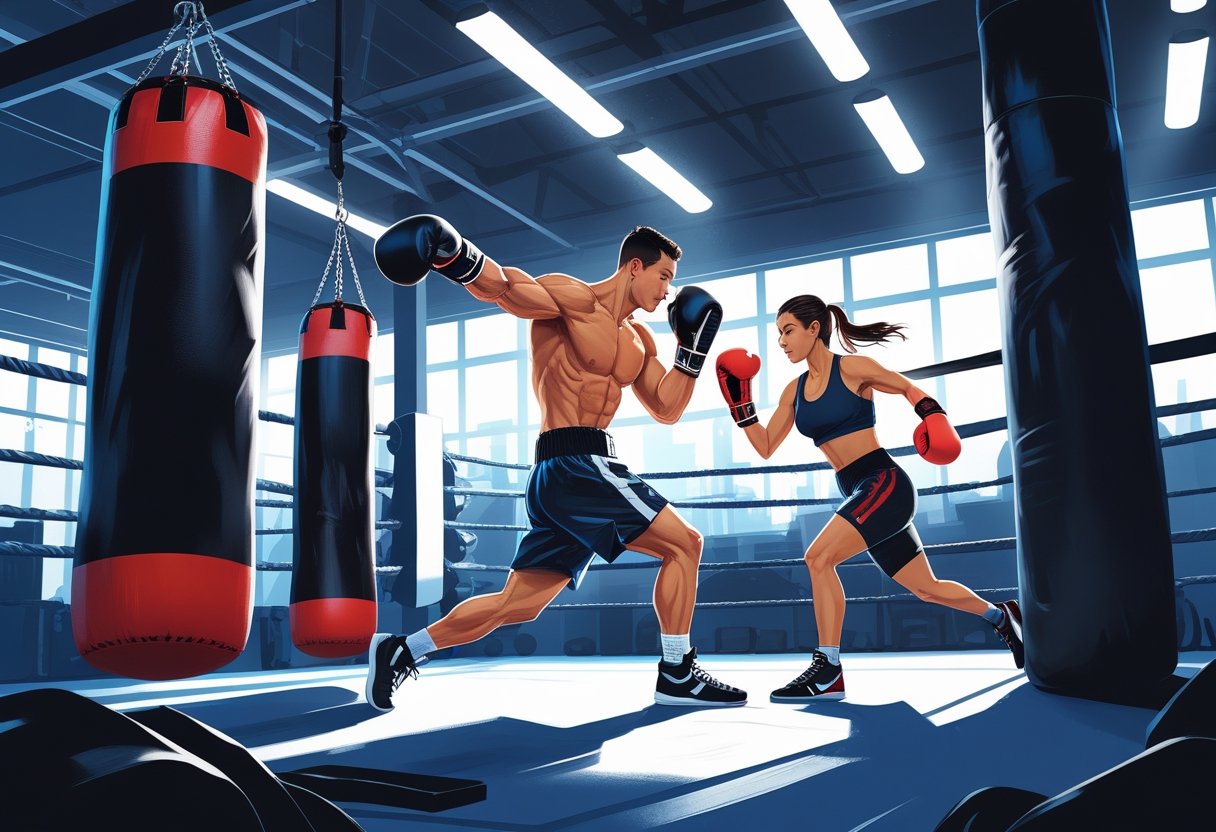Trying to maximize your fitness results? Picking the right sport really can make a huge difference in how many calories you actually burn. A lot of athletes—and honestly, just anyone who likes to sweat—look for activities that torch the most energy, so their training feels worth the effort and helps them hit their health goals faster.
Some high-intensity sports can burn anywhere from 500 up to almost 1,000 calories per hour, which is wild if you think about it. Of course, how much you actually burn depends on stuff like how hard you go, your body weight, and even your movement style. Comparing how different sports stack up in terms of energy use can help you figure out which ones might fit best into your training routine.
1) Running – Burns up to 900 calories per hour depending on intensity

Running is easily one of the top calorie-burners out there. But the exact number? That depends on a few things.
Your weight matters a lot. If you weigh more, you’ll burn more calories running the same distance as someone lighter, which seems pretty fair.
How fast and hard you run makes a big difference too. Push the pace or tackle tougher workouts, and your calorie burn jumps up.
Most people burn somewhere between 400 and 800 calories an hour at a moderate pace, but if you really crank up the intensity, you might hit 900 an hour.
Running uphill or on trails? That’ll push your energy use even higher compared to just jogging on flat pavement.
Because running is high-impact and gets a bunch of muscle groups working at once, it’s no surprise it burns so much.
Plus, it’s just so easy to do. You don’t need much gear and you can run almost anywhere, which helps you stick with it and keep those calorie-burning sessions consistent.
2) Boxing – Can burn nearly 980 calories per hour with high-intensity training

Boxing is another heavyweight in the calorie-burning department. If you weigh around 160-180 pounds, you’ll probably burn 400-800 calories per hour in a moderate session.
But crank up the intensity—think intense sparring or advanced drills—and you can get close to 1000 calories an hour, especially if you’re really pushing it.
Boxing is a full-body thing. Throwing punches works your upper body, while all that footwork and dodging keeps your legs and core fired up.
Want to burn even more? Focus on heavy bag work, jump rope, and sparring. Those activities really rack up the calorie count compared to just practicing technique.
Again, heavier boxers tend to burn more, just like in running.
If you’ve ever watched pro-level sparring, you know those athletes are moving non-stop. That constant activity keeps the heart rate up and is a big reason boxing is such a calorie killer.
3) Swimming – Around 500 to 900 calories per hour depending on stroke and speed
Swimming is a bit underrated sometimes, but it’s fantastic for burning calories and works your whole body. How many calories you burn? Well, that depends.
Heavier swimmers will use up more energy than lighter ones, just like with the other sports.
The stroke you pick matters too. Butterfly and fast freestyle sprints torch the most calories, while breaststroke or backstroke are a bit less demanding.
Go all-out in the pool, and you could hit 800-900 calories per hour. Take it easy, and you’re looking at more like 400-600 per hour.
The water itself adds resistance, so your muscles have to work harder than they would on land. That’s part of why swimming is so effective for both calorie burn and building strength.
Longer swims obviously add up to more calories, but keeping up a high intensity the whole time isn’t easy, especially for beginners.
More experienced swimmers with good technique usually burn more, since they can keep up a faster pace and handle tougher sets.
How Calorie Burn Is Measured In Sports
How many calories you burn during sports comes down to stuff like your weight, how hard you’re working, and how long you keep at it. But even with the same workout, people can burn different amounts because everyone’s metabolism is a bit unique.
Factors That Influence Calorie Expenditure
Body weight is the big one. Heavier folks just burn more calories per hour than lighter people doing the same thing.
If you weigh 100kg, you’ll burn about 25-30% more calories than someone at 70kg, simply because it takes more energy to move a bigger body.
Body composition matters too. Muscle burns more calories than fat—even when you’re just sitting around. So, athletes with more muscle usually torch more calories during sports.
Environmental conditions can sneakily affect your calorie burn. Cold weather makes your body work to stay warm, while hot and humid days push your cooling systems into overdrive—both scenarios mean more calories burned.
The type of movement plays a role as well. Sports that use your whole body or have lots of quick changes and explosive moves will always burn more than activities that are more limited or repetitive.
Role Of Intensity And Duration
Exercise intensity is a huge factor. Go hard, and you might burn 600-1000 calories an hour. Take it easy, and you’ll land more in the 300-500 range.
For example, swimming butterfly at full tilt can hit 900 calories per hour, while a slow freestyle might be closer to 570.
Duration is pretty straightforward—the longer you go, the more you burn. Play basketball for 30 minutes at a moderate pace, that’s about 300 calories. Double the time, double the burn (roughly).
Interval training is a bit of a secret weapon. Mixing sprints with recovery periods keeps your metabolism revved up, so you keep burning calories long after you’re done.
Here’s a quick breakdown of heart rate zones for intensity:
- 50-60% max heart rate: Light
- 60-70% max heart rate: Moderate
- 70-85% max heart rate: Vigorous
- 85-95% max heart rate: High
Individual Differences In Metabolism
Basal metabolic rate (how many calories you burn just existing) can be all over the map. Genetics, age, and hormones play a part.
Men usually burn 10-15% more calories than women during the same activity, mostly because they tend to have more muscle and higher testosterone.
Age isn’t always kind to metabolism. After 30, your calorie burn drops about 2-3% per decade. Younger athletes just have it easier sometimes.
Fitness level can be a double-edged sword. As you get fitter, your body gets more efficient, so you might burn fewer calories at the same intensity—unless you push harder or longer.
Genetics can account for up to a quarter of the difference in metabolic rates. Some people just naturally burn more (or less) during activity.
And as you train more, your body adapts, so you might burn a little less doing the same workout over time. It’s a bit of a moving target.
Tips For Maximizing Calorie Burn During Exercise
If you want to really ramp up your calorie burn, you’ll need a mix of smart training, good form, and solid nutrition. It’s not just about going harder—strategy matters.
Incorporating Interval Training
Interval training is all about switching between all-out effort and easy recovery. It spikes your metabolism, so you keep burning calories even after you leave the gym.
High-Intensity Interval Training (HIIT) gets you more bang for your buck compared to steady cardio. A typical HIIT workout might be 30 seconds all-out, then 30-90 seconds of slower movement or rest.
You can use intervals with almost any sport—running, cycling, swimming, rowing. For example, do a 20-second sprint, then jog or rest for 40 seconds, and repeat for 15-20 minutes.
The “afterburn” effect from intervals can last up to a whole day. Your body needs extra energy to recover, clear out waste, and repair muscles.
Circuit training is another option. It mixes strength moves with little rest, keeping your heart rate up and muscles working, so you get double the calorie burn.
Importance Of Proper Technique
Form matters—a lot. Good technique means you’re using the right muscles and working harder, which means more calories burned and fewer injuries.
For running, keep your posture tall, land on your midfoot, and relax your arms at about 90 degrees. This helps your core work and makes your stride more efficient.
In swimming, better technique and breathing let you go faster for longer, which absolutely boosts your calorie burn.
For lifting weights, using a full range of motion recruits more muscle fibers and burns more calories than half-reps or sloppy form.
And don’t forget your core. Engaging those abs during squats, lunges, or even upper body exercises makes everything harder—and yes, that means more calories burned.
Balancing Diet With Physical Activity
Pre-workout nutrition gives you the fuel to push through intense exercise, while what you eat afterward helps your body bounce back and keeps your metabolism humming. The way you time your meals can actually fire up calorie burn while you train, too.
Consuming protein a couple of hours before exercise helps your muscles hang in there during tough workouts. Lean proteins, in particular, take a bit more effort for your body to digest, so you end up burning a few extra calories in the process—thanks to the thermic effect of food.
When you eat carbs matters. If you go for complex carbs about an hour or two before you hit the gym, you’ll have steadier energy for those longer or more intense sessions that really torch calories.
Staying hydrated makes a bigger difference than most people realize. Even being just a little dehydrated can sap your strength and lower workout intensity by up to 15%. That’s a lot of lost calorie burn, honestly.
Getting some protein in within half an hour after you finish helps your muscles recover and grow. More muscle means your body naturally burns more calories, even when you’re just chilling out later.






